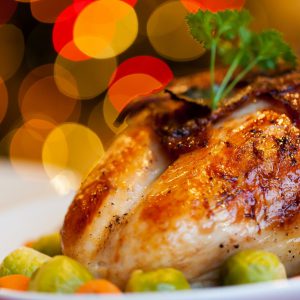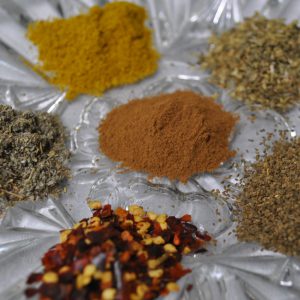by Samantha Kennedy | Oct 26, 2017

Photo credit:
www.Pexels.com (Creative Commons License)
According to the National Turkey Federation, 88% of American families eat turkey on Thanksgiving. That’s over 46 million turkeys! Served as the main dish, it is complemented by a variety of sweet and savory side dishes, many of which are family traditions made from recipes passed down through the generations.
Why do we eat turkey on Thanksgiving, anyway? Well, it’s kind of a funny story. While historians generally agree that turkey wasn’t eaten at the First Thanksgiving in Plymouth in 1621, it was well-documented that settlers often hunted wild turkeys as a source of protein, and subsequent celebrations often included turkey. After President Lincoln declared Thanksgiving a national holiday in 1863, turkey became a staple on many Thanksgiving tables.
When choosing a turkey, there are a few decisions to make. How many people will be eating? Will it be roasted, smoked, or deep-fried? Is frozen or fresh preferred?
When it comes to the proper size, a pound per person is a great rule of thumb. This includes the total weight of the bird, not just the meat. Also, the ratio of white meat to dark meat is about 7:3 (70% white meat, 30% dark), so if there are a lot of dark meat lovers around the table, additional thighs and drumsticks may need to be purchased.
Roasting is the most common way to cook a turkey. This method involves placing the turkey in a large roasting pan and cooking it in the oven slowly over several hours. The turkey is usually placed breast-side up in the pan and basted periodically to prevent drying. The lid or foil is also removed the last 30 to 45 minutes of roasting time to brown the skin and give the turkey that gorgeous presentation.
Vegetables such as potatoes, carrots, or Brussels sprouts may be added to the roasting pan to cook concurrently. For best results, roast the turkey at 325˚F for 15 minutes per pound. For example, a 15 pound turkey would take 3 hours and 45 minutes.
Smoked turkeys are usually fully cooked (read the label to be sure) and just need to be reheated. Keep in mind, smoking is done to impart flavor and does not increase the turkey’s shelf life. Follow the instructions on the package to properly reheat the turkey.
Deep-fried turkeys are submerged in very hot oil and cook more quickly than roasted turkeys. Turkeys can be deep fried in a very large stockpot or in a designated turkey fryer. Only use enough oil to cover the turkey. Too much oil can cause a fire or overflow when the turkey is added to the cooker.
To determine the amount of oil, place the turkey in the cooker and add enough water to cover the bird. Then remove the bird. The water line will indicate the level of oil needed to adequately fry the turkey. For best results, let the turkey warm to room temperature before frying, and fry the turkey for 3 minutes per pound plus 5 minutes per bird.
Remember, the size of the cooker will dictate the size of the turkey. The turkey should fit easily without being forced. Wedging a turkey into a cooker that is too small could cause uneven cooking, or worse, a fire.
As for frozen versus fresh, there is no difference in flavor. However, frozen turkeys can be purchased months in advance and kept frozen until needed. Fresh turkeys should be purchased no more than two days in advance for maximum safety and freshness.
The safest way to thaw a frozen turkey is in the refrigerator. This will take pre-planning. The general rule of thumb is 24 hours of refrigerator thawing per 5 pounds. For example, a 15 pound turkey should take 3 full days (72 hours) to thaw completely.
However the turkey is cooked this year, have a Happy Thanksgiving!
by Samantha Kennedy | Aug 24, 2017
 With today’s continued focus on healthy eating and the dangers of high blood pressure, seasoning and cooking with salt has decreased. Alternative seasonings such as herbs and spices are excellent additions to any dish without the dreaded sodium. Herbs and spices are easy to use and can add a variety of delicious flavor combinations to any family favorite.
With today’s continued focus on healthy eating and the dangers of high blood pressure, seasoning and cooking with salt has decreased. Alternative seasonings such as herbs and spices are excellent additions to any dish without the dreaded sodium. Herbs and spices are easy to use and can add a variety of delicious flavor combinations to any family favorite.
The difference between an herb and a spice is the part of the plant used. Herbs come from the leaves and soft stems of the plant. Spices are taken from the roots, seeds, bark, fruit, or flowers of the plant. Spices tend to have a stronger flavor than herbs, and are usually used in smaller quantities.
Besides being a healthy substitute for salt, herbs and spices can also replace added fat and sugar without contributing extra calories. Instead of adding extra sugar to oatmeal, for example, try using cinnamon or allspice.
Add cumin or ground black pepper to more savory dishes instead of reaching for the salt shaker or butter. Try seasoning meats with herbs and spices instead of coating them in breading or gravy.
Not all herbs and spices pair well with all types of foods. Herbs and spices should be used to enhance and complement the flavor of food without taking it over completely.
A strong herb such as rosemary would completely overwhelm a mild-tasting food like peas or other vegetable. Conversely, a mild herb such as parsley would be completely overwhelmed by a strong-tasting food such as lamb or beef.
Dried herbs can be used instead of fresh herbs in recipes, and vice versa. Keep in mind the flavor of dried herbs is much more concentrated than that of fresh, so reduce the amount accordingly.
Use only a quarter to half as much dried as fresh. Start with a smaller amount, and then add as needed to achieve the desired taste.
Look for herbs with a bright green color and little or no wilting when choosing fresh ones. Avoid bunches showing signs of mold, slime, or pests.
Wash fresh herbs in clean, cool water to get rid of any sand. Fresh herbs need to be stored in the refrigerator, in an unsealed plastic bag, to maintain optimal freshness. They can last up to three weeks, though should be used within a week for the best flavor.
Dried herbs and spices, if stored correctly, do not spoil. However, they will lose their flavor and aroma over time.
Ideally, flaked or ground herbs and spices should be replaced every six months for maximum flavor, but can remain viable for up to three years. Whole spices such as cinnamon sticks and peppercorns can remain effective for up to five years.
Not all herbs and spices are created equal. When using them in cooking, it is important to remember the more delicate herbs such as basil and chives should be added right before serving to preserve their flavor.
Less delicate herbs such as thyme and oregano can be added earlier in the cooking process since they retain their flavor better. When creating herb blends, mix, match, and be creative. Add them to a cheese shaker for easy access during meals.
To learn more, sign up for the Extension Cooking Class series which starts September 7, 2017 at the UF/IFAS Wakulla County Extension Office at 84 Cedar Avenue in Crawfordville. Start time is 6:00 p.m. and the cost is $10.
For additional tips about cooking with herbs and spices, call Samantha at the UF/IFAS Wakulla County Extension office at (850) 926-3931.

by Ricki McWilliams | Dec 11, 2014
 Being sick during the holiday season is no fun. Did you know the flu is not the only thing that can have you feeling under the weather? The Centers for Disease Control and Prevention (CDC) estimate that each year roughly 1 in 6 Americans (or 48 million people) get sick, 128,000 are hospitalized, and 3,000 die of foodborne diseases (CDC, 2014). This holiday season, UF/IFAS Extension Agents will be available to help keep you and the ones you care about safe by reminding you of the United States Department of Agriculture ‘s four steps to safer food handling this holiday season:
Being sick during the holiday season is no fun. Did you know the flu is not the only thing that can have you feeling under the weather? The Centers for Disease Control and Prevention (CDC) estimate that each year roughly 1 in 6 Americans (or 48 million people) get sick, 128,000 are hospitalized, and 3,000 die of foodborne diseases (CDC, 2014). This holiday season, UF/IFAS Extension Agents will be available to help keep you and the ones you care about safe by reminding you of the United States Department of Agriculture ‘s four steps to safer food handling this holiday season:
- Wash your hands and your cooking surfaces before you start, when you will touch different foods, and after you finish preparing a dish.
- Separate cooked foods and ready-to-eat foods from foods that still need to be prepared.
- Always cook and reheat your foods to above 140 degrees Fahrenheit.
- Chill your leftovers. Don’t let your dishes sit out without refrigerating or keeping them heated. Throw out foods that have been between 40 degrees and 140 degrees Fahrenheit for more than 2 hours.
Have a question that is not related to food safety, like:
- How do I make a brine for my turkey?
- I ran out of eggs – is there a substitute?
- I couldn’t find any buttermilk. What do I do?
…Don’t worry – call the UF/IFAS Extension Northwest District Family and Consumer Sciences (FCS) HOLIDAY FOOD HOTLINE. Northwest District FCS agents will be available 8am – 8pm CST/9 am – 9pm EST by calling 850-888-2412 (December 15 – January 1) to assist you with food preparation, food safety, or any other kitchen concerns you may have.
The best part is you can always count on UF/IFAS Extension to provide you with research-based information!
Holiday Food Hotline
850-888-2412
References:
Centers for Disease Control and Prevention (2014). “Estimates of Foodborne Illness in the United States” retrieved December 11, 2014 from http://www.cdc.gov/foodborneburden/
United States Department of Agriculture (2014). “Check Your Steps: Food Safe Families” retrieved December 11, 2014 from http://www.fsis.usda.gov/wps/portal/fsis/topics/food-safety-education/featured-campaign




